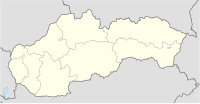Muráň Castle
| Muráň Castle | |
|---|---|
| Muráň, Slovakia | |
 The main gate of the castle. | |
| Coordinates | 48°45′33″N 20°03′35″E / 48.759174°N 20.059710°E |
| Site information | |
| Condition | Ruined |
| Site history | |
| Built | 13th century, before 1271 |
| Demolished | 18th century |
Muráň Castle (Slovak: Muránsky hrad), is a ruin of a medieval castle situated above the village of Muráň, in the Muránska planina National Park in Slovakia. The castle is noteworthy for its unusually high altitude of 935 m making it the third highest located castle in Slovakia.[1] It also figures in several romantic legends about its remarkable owners. Muráň Castle was built in the 13th century on a cliff overlooking a regional trade route. Its name was mentioned for the first time in 1271 ("arx Mwran").
One of its owners, the robber baron Matúš Bašo, transformed the castle into a stronghold of bandits who robbed merchants and looted villages. After a siege by the royal army, the castle fell in 1548 and Matúš Bašo was executed.
Another famous owner was Maria Széchy, better known as "The Venus of Muráň". This astonishingly independent woman divorced her second husband to marry the love of her life – magnate Ferenc Wesselényi. When Wesselényi was besieging Muráň Castle, which was occupied by her relatives at the time, she even managed to get his soldiers inside through trickery. In 1666, Wesselényi organized a failed coup against Leopold I, but he died before any major confrontation. Subsequently, Maria Széchy bravely led a defense of the castle against Imperial troops. Outnumbered, she eventually surrendered to Charles of Lorraine in 1670.
The castle was damaged twice in the 18th century by fire[1], including in 1760.
External links
48°45′35.98″N 20°03′39.34″E / 48.7599944°N 20.0609278°E
- ^ a b Kollár, Daniel; Nešpor, Jaroslav (2007). Castles - Most Beautiful Ruins (1st ed.). Bratislava: DAJAMA. pp. 100–103. ISBN 978-80-89226-42-9.


